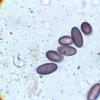
21-12-2025 09:32
Hello.A tiny ascomycete found embedded in wood in

21-12-2025 21:32
Pol DebaenstHello, Garden, Burgweg 19, Veurne, BelgiumOn 10/1

22-12-2025 23:38
Patrice TANCHAUDBonsoir, récolte sur un mur en pierre, apothéci

22-12-2025 00:47
Patrice TANCHAUDBonsoir, récolte à proximité du milieu dunaire

21-12-2025 21:40
Isabelle CharissouBonjour, j'aimerais connaitre les références de

20-12-2025 23:08
Patrice TANCHAUDBonsoir, récolte sur sol sablonneux dans l'arri�
Ascobolus
Malcolm Greaves,
23-03-2020 18:48
Hello all
This Ascobolus was on Goose dung.
White apothecia turns dark brown on maturity, mostly 0.5mm across. Asci protruding more as it matures and eventually almost looks like A imersus.
There is bluing in Meltzers.
The spores have a smooth surface with few fissures 17-22 * 9-10
Paraphyses mostly cylindrical but one or two with swollen apex.
I have tried looking as Van Brummelen but not managed to come to any firm conclusion especially as some of the words used in the descriptions especially in the key to sections are unknown to me.
Thanks
Mal
Norbert Heine,
24-03-2020 12:44

Re : Ascobolus
Hello Malcolm,
compare with Ascobolus brantophilus. Dissing described this species in 1989 (Four new coprophilous species of Ascobolus and Saccobolus from Greenland, Opera Bot. 100: 43-50). With strongly protruding asci and spores 21-23 x 10-11 with only few longitudinal often forked crackings this should be your species! It seems to be known from old goose dung in arctic areas only. Where did you find it?
I'll attach a pdf with the description and the drawings.
Stay healthy, Norbert
Michel Delpont,
24-03-2020 14:38

Re : Ascobolus
Hello Malcolm!
I discover your message and I also think of this species as you say Norbert; if this is confirmed it is a very nice find!
Michel.
Malcolm Greaves,
24-03-2020 16:54
Re : Ascobolus
Norbert (and Michel)
Thanks for that. It was found by a lake in the North of England. There were lots of Canada goose, (Branta canadensis) and swans but there may have been others about.
The description by Dissing mentions a gelatinous sheath which I hadn't noticed originally but is definitely there so I think this is a very good fit for the A. brantophilus.
I will send a specimen to Chris Yeates and see if he can confirm. As the area is now in lockdown it is lucky that there are lots of fruitbodies available on the one sample I have.
Thanks once again.
Mal
Thanks for that. It was found by a lake in the North of England. There were lots of Canada goose, (Branta canadensis) and swans but there may have been others about.
The description by Dissing mentions a gelatinous sheath which I hadn't noticed originally but is definitely there so I think this is a very good fit for the A. brantophilus.
I will send a specimen to Chris Yeates and see if he can confirm. As the area is now in lockdown it is lucky that there are lots of fruitbodies available on the one sample I have.
Thanks once again.
Mal
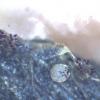

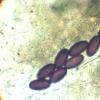

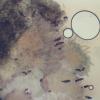
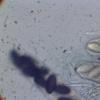
 Ascobolus-brantophilus-Dissing-0001.pdf
Ascobolus-brantophilus-Dissing-0001.pdf